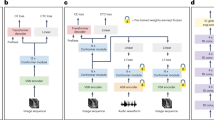Abstract
Over the past decade, artificial intelligence has been propelled forward by advances in machine learning algorithms and computational hardware, opening up myriads of new avenues for scientific research. Nevertheless, virtual assistants and voice control have yet to be widely used in the natural sciences. Here, we present ChemVox, an interactive Amazon Alexa skill that uses speech recognition to perform quantum chemistry calculations. This new application interfaces Alexa with cloud computing and returns the results through a capable device. ChemVox paves the way to making computational chemistry routinely accessible to the wider community.
This is a preview of subscription content, access via your institution
Access options
Access Nature and 54 other Nature Portfolio journals
Get Nature+, our best-value online-access subscription
$29.99 / 30 days
cancel any time
Subscribe to this journal
Receive 12 digital issues and online access to articles
$99.00 per year
only $8.25 per issue
Buy this article
- Purchase on Springer Link
- Instant access to full article PDF
Prices may be subject to local taxes which are calculated during checkout


Similar content being viewed by others
Data availability
The database of ~5000 unique chemical words is available as Supplementary Data 1.
Code availability
ChemVox is available on the Alexa Skills Store (https://www.amazon.com/dp/B08G1C97J5). The source code is available as open source on GitHub (https://github.com/mtzgroup/ChemVox) and Zenodo (https://doi.org/10.5281/zenodo.4156443). A video tutorial showing how to build the code into an Alexa skill is available on YouTube (https://youtu.be/mQinUlxQU3k). An introductory video tutorial on ChemVox is also provided as Supplementary Video 1.
References
Hoy, M. B. Alexa, Siri, Cortana, and more: an introduction to voice assistants. Med. Ref. Serv. Quart. 37, 81–88 (2018).
Fox Rubin, B. Amazon sees Alexa devices more than double in just one year. CNET https://www.cnet.com/news/amazon-sees-alexa-devices-more-than-double-in-just-one-year (2020).
Paganini, M., de Oliveira, L. & Nachman, B. CaloGAN: simulating 3D high energy particle showers in multilayer electromagnetic calorimeters with generative adversarial networks. Phys. Rev. D 97, 014021 (2018).
Modarres, M. H. et al. Neural network for nanoscience scanning electron microscope image recognition. Sci. Rep. 7, 13282 (2017).
Wei, G.-W. Protein structure prediction beyond AlphaFold. Nat. Mach. Intell. 1, 336–337 (2019).
Vandal, T., Kodra, E. & Ganguly, A. R. Intercomparison of machine learning methods for statistical downscaling: the case of daily and extreme precipitation. Theor. Appl. Climatol. 137, 557–570 (2019).
Crane-Droesch, A. Machine learning methods for crop yield prediction and climate change impact assessment in agriculture. Environ. Res. Lett. 13, 114003 (2018).
Fluke, C. J. & Jacobs, C. Surveying the reach and maturity of machine learning and artificial intelligence in astronomy. WIREs Data Min. Knowl. Disc. 10, e1349 (2020).
Maryasin, B., Marquetand, P. & Maulide, N. Machine learning for organic synthesis: are robots replacing chemists? Angew. Chem. Int. Ed. 57, 6978–6980 (2018).
Halford, B. Meet your new lab assistant. Chem. Eng. News 95, 26–27 (2017).
Schütt, K. T., Gastegger, M., Tkatchenko, A., Müller, K. R. & Maurer, R. J. Unifying machine learning and quantum chemistry with a deep neural network for molecular wavefunctions. Nat. Commun. 10, 5024 (2019).
Seritan, S., Thompson, K. & Martínez, T. J. TeraChem Cloud: a high-performance computing service for scalable distributed GPU-accelerated electronic structure calculations. J. Chem. Inf. Model. 60, 2126–2137 (2020).
Thackston, R. & Fortenberry, R. C. The performance of low-cost commercial cloud computing as an alternative in computational chemistry. J. Comput. Chem. 36, 926–933 (2015).
Seritan, S. et al. TeraChem: a graphical processing unit-accelerated electronic structure package for large-scale ab initio molecular dynamics. WIRES Comp. Mol. Sci. https://doi.org/10.1002/wcms.1494 (2020).
Kim, S. et al. PubChem 2019 update: improved access to chemical data. Nucleic Acids Res. 47, D1102–D1109 (2019).
Adamo, C. & Barone, V. Toward reliable density functional methods without adjustable parameters: the PBE0 model. J. Chem. Phys. 110, 6158–6170 (1999).
Liu, F., Luehr, N., Kulik, H. J. & Martínez, T. J. Quantum chemistry for solvated molecules on graphical processing units using polarizable continuum models. J. Chem. Theory Comput. 11, 3131–3144 (2015).
Acknowledgements
This work was supported by the Office of Naval Research (N00014-18-1-2659 and N00014-18-1-2624). The authors thank A. Esposito for artistic contributions.
Author information
Authors and Affiliations
Contributions
U.R. conceived this project. U.R., A.V., E.P., H.W., S.S. and T.J.M. made substantial contributions to the design and implementation of the work and wrote the manuscript.
Corresponding author
Ethics declarations
Competing interests
The authors declare no competing interests.
Additional information
Peer review information Nature Computational Science thanks Jan Jensen and the other, anonymous, reviewer(s) for their contribution to the peer review of this work. Fernando Chirigati was the primary editor on this article and managed its editorial process and peer review in collaboration with the rest of the editorial team.
Publisher’s note Springer Nature remains neutral with regard to jurisdictional claims in published maps and institutional affiliations.
Supplementary information
Supplementary Information
Supplementary Note, Fig. 1 and Tables 1,2
Supplementary Data 1
Database of chemical words used to train ChemVox speech recognition
Supplementary Video 1
Introductory video tutorial on ChemVox
Rights and permissions
About this article
Cite this article
Raucci, U., Valentini, A., Pieri, E. et al. Voice-controlled quantum chemistry. Nat Comput Sci 1, 42–45 (2021). https://doi.org/10.1038/s43588-020-00012-9
Received:
Accepted:
Published:
Issue Date:
DOI: https://doi.org/10.1038/s43588-020-00012-9



